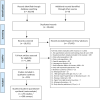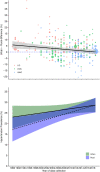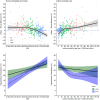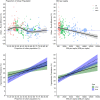Urban-rural differences in hypertension prevalence in low-income and middle-income countries, 1990-2020: A systematic review and meta-analysis
- PMID: 36007101
- PMCID: PMC9410549
- DOI: 10.1371/journal.pmed.1004079
Urban-rural differences in hypertension prevalence in low-income and middle-income countries, 1990-2020: A systematic review and meta-analysis
Abstract
Background: The influence of urbanicity on hypertension prevalence remains poorly understood. We conducted a systematic review and meta-analysis to assess the difference in hypertension prevalence between urban and rural areas in low-income and middle-income countries (LMICs), where the most pronounced urbanisation is underway.
Methods and findings: We searched PubMed, Web of Science, Scopus, and Embase, from 01/01/1990 to 10/03/2022. We included population-based studies with ≥400 participants 15 years and older, selected by using a valid sampling technique, from LMICs that reported the urban-rural difference in hypertension prevalence using similar blood pressure measurements. We excluded abstracts, reviews, non-English studies, and those with exclusively self-reported hypertension prevalence. Study selection, quality assessment, and data extraction were performed by 2 independent reviewers following a standardised protocol. Our primary outcome was the urban minus rural prevalence of hypertension. Hypertension was defined as systolic blood pressure ≥140 mm Hg and/or diastolic blood pressure as ≥90 mm Hg and could include use of antihypertensive medication, self-reported diagnosis, or both. We investigated heterogeneity using study-level and socioeconomic country-level indicators. We conducted meta-analysis and meta-regression using random-effects models. This systematic review and meta-analysis has been registered with PROSPERO (CRD42018091671). We included 299 surveys from 66 LMICs, including 19,770,946 participants (mean age 45.4 ± SD = 9 years, 53.0% females and 63.1% from rural areas). The pooled prevalence of hypertension was 30.5% (95% CI, 28.9, 32.0) in urban areas and 27.9% (95% CI, 26.3, 29.6) in rural areas, resulting in a pooled urban-rural difference of 2.45% (95% CI, 1.57, 3.33, I-square: 99.71%, tau-square: 0.00524, Pheterogeneity < 0.001). Hypertension prevalence increased over time and the rate of change was greater in rural compared to urban areas, resulting in a pooled urban-rural difference of 5.75% (95% CI, 4.02, 7.48) in the period 1990 to 2004 and 1.38% (95% CI, 0.40, 2.37) in the period 2005 to 2020, p < 0.001 for time period. We observed substantial heterogeneity in the urban-rural difference of hypertension, which was partially explained by urban-rural definition, probably high risk of bias in sampling, country income status, region, and socioeconomic indicators. The urban-rural difference was 5.67% (95% CI, 4.22, 7.13) in low, 2.74% (95% CI, 1.41, 4.07) in lower-middle and -1.22% (95% CI, -2.73, 0.28) in upper-middle-income countries in the period 1990 to 2020, p < 0.001 for country income. The urban-rural difference was highest for South Asia (7.50%, 95% CI, 5.73, 9.26), followed by sub-Saharan Africa (4.24%, 95% CI, 2.62, 5.86) and reversed for Europe and Central Asia (-6.04%, 95% CI, -9.06, -3.01), in the period 1990 to 2020, p < 0.001 for region. Finally, the urban-rural difference in hypertension prevalence decreased nonlinearly with improvements in Human Development Index and infant mortality rate. Limitations included lack of data available from all LMICs and variability in urban and rural definitions in the literature.
Conclusions: The prevalence of hypertension in LMICs increased between 1990 and 2020 in both urban and rural areas, but with a stronger trend in rural areas. The urban minus rural hypertension difference decreased with time, and with country-level socioeconomic development. Focused action, particularly in rural areas, is needed to tackle the burden of hypertension in LMICs.
Conflict of interest statement
The authors have declared that no competing interests exist.
Figures




Similar articles
-
Prevalence, awareness, treatment, and control of hypertension in rural and urban communities in high-, middle-, and low-income countries.JAMA. 2013 Sep 4;310(9):959-68. doi: 10.1001/jama.2013.184182. JAMA. 2013. PMID: 24002282
-
Elevated blood pressure among adolescents in sub-Saharan Africa: a systematic review and meta-analysis.Lancet Glob Health. 2023 Aug;11(8):e1238-e1248. doi: 10.1016/S2214-109X(23)00218-8. Lancet Glob Health. 2023. PMID: 37474231
-
The state of hypertension care in 44 low-income and middle-income countries: a cross-sectional study of nationally representative individual-level data from 1·1 million adults.Lancet. 2019 Aug 24;394(10199):652-662. doi: 10.1016/S0140-6736(19)30955-9. Epub 2019 Jul 18. Lancet. 2019. PMID: 31327566
-
Urbanisation and asthma in low-income and middle-income countries: a systematic review of the urban-rural differences in asthma prevalence.Thorax. 2019 Nov;74(11):1020-1030. doi: 10.1136/thoraxjnl-2018-211793. Epub 2019 Jul 5. Thorax. 2019. PMID: 31278168 Free PMC article.
-
Systematic review of oral health in slums and non-slum urban settings of Low and Middle-Income Countries (LMICs): Disease prevalence, determinants, perception, and practices.PLoS One. 2024 Nov 8;19(11):e0309319. doi: 10.1371/journal.pone.0309319. eCollection 2024. PLoS One. 2024. PMID: 39514587 Free PMC article.
Cited by
-
Trends in hypertension prevalence, awareness, treatment, and control: an 8-year follow-up study from rural North India.Sci Rep. 2023 Jun 19;13(1):9910. doi: 10.1038/s41598-023-37082-4. Sci Rep. 2023. PMID: 37337044 Free PMC article.
-
Two-Year Hypertension Incidence Risk Prediction in Populations in the Desert Regions of Northwest China: Prospective Cohort Study.J Med Internet Res. 2025 Mar 12;27:e68442. doi: 10.2196/68442. J Med Internet Res. 2025. PMID: 40072485 Free PMC article.
-
Prevalence and determinants of hypertension among adults of reproductive age in Tanzania: analysis of a cross-sectional Demographic and Health Survey.BMJ Open. 2025 Jun 19;15(6):e094387. doi: 10.1136/bmjopen-2024-094387. BMJ Open. 2025. PMID: 40537227 Free PMC article.
-
Prevalence of obesity related hypertension among overweight or obese adults in River Nile State in Northern Sudan: a community based cross-sectional study.Cardiovasc Diagn Ther. 2023 Apr 28;13(2):384-394. doi: 10.21037/cdt-22-473. Epub 2023 Mar 10. Cardiovasc Diagn Ther. 2023. PMID: 37583681 Free PMC article.
-
[Spatial analysis of hypertension in Peruvian adults, 2022].Arch Peru Cardiol Cir Cardiovasc. 2023 Jun 30;4(2):48-54. doi: 10.47487/apcyccv.v4i2.296. eCollection 2023 Apr-Jun. Arch Peru Cardiol Cir Cardiovasc. 2023. PMID: 37780947 Free PMC article. Spanish.
References
-
- Global burden of 87 risk factors in 204 countries and territories, 1990–2019: a systematic analysis for the Global Burden of Disease Study 2019. Lancet. [cited 2020 Nov 26]. https://www.thelancet.com/journals/lancet/article/PIIS0140-6736(20)30752... - PMC - PubMed
-
- Global burden of 369 diseases and injuries in 204 countries and territories, 1990–2019: a systematic analysis for the Global Burden of Disease Study 2019. Lancet. [cited 2020 Nov 26]. https://www.thelancet.com/journals/lancet/article/PIIS0140-6736(20)30925... - PMC - PubMed

